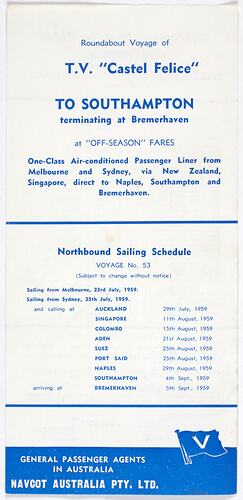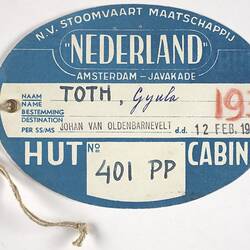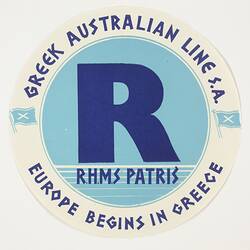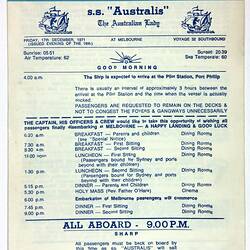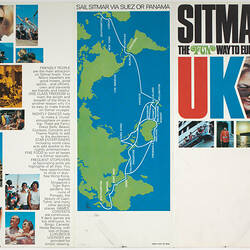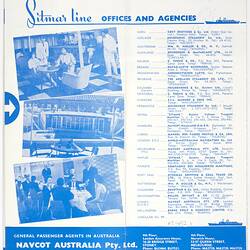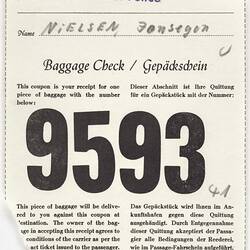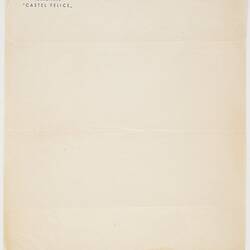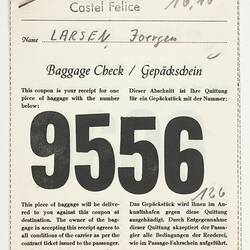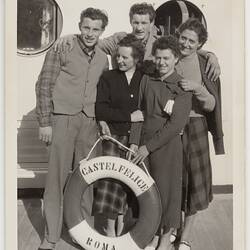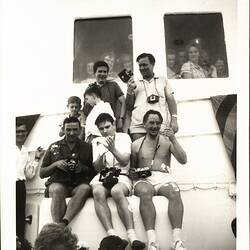Summary
History of the post World War II Migrant Ship Castel Felice. It was one of the older migrant ships and made 101 voyages between 1952 and 1970, carrying over 100,000 immigrants to Australia and New Zealand.
The Castel Felice ventured to Australia as an immigrant ship on a total of 101 voyages between 1952 and 1970, carrying over 100,000 immigrants to Australia and New Zealand.
She was commanded by an Italian crew and carried passengers from many different countries including Italy, Germany and Britain. Many passengers remember the rough seas and shabby state of the aged ship with apprehension and delight.
Facts at a Glance
Dimensions: 493 x 64 ft (150.3 x 19.6 m)
Registered Tonnage: 12,478 tons gross
Service Speed: 16 knots
Propulsion: Reduction geared steam turbines / twin screws
Shipping Line: Sitmar Line (Società Italiana Transporti Marittima)
History of the Ship
Originally named the Kenya, the immigrant ship Castel Felice began her life carrying passengers and cargo between India and Africa for the British-India Steam Navigation Co.
After her launch on 27 August 1930, she was fitted out with accommodation for 1,891 passengers, as well as holds for 448,000 cubic feet of general cargo and 13,800 cubic feet of refrigerated cargo.
Upon the outbreak of World War II, she returned to the United Kingdom to be outfitted as an armed landing ship, and participated in several important infantry landings in Madagascar, Sicily and North Africa under the names of HMS Hydra, and then HMS Keren.
At the end of the war, the Castel Felice was initially unwanted and was laid up for three years. Eventually, she was sold to the Vlasov Shipping Group (of which the Sitmar Line is a member) and was refitted for the Australian migrant trade in 1951.
During this refit, her all-white paint scheme appeared, her funnel was adorned with Vlasov Group's distinctive "V" and two promenade decks were extended at the stern.
Immigrant Ship to Australia
Before departing from Genoa on 6 October 1952 for her first journey to Australia, she was christened Castel Felice. She arrived in Melbourne on 7 November. Between 1952 and 1955, the Castel Felice made only three voyages to Australia (but many to the Americas) before again being refurbished.
The new refit offered many conveniences including a small number of first class cabins, air conditioning, a swimming pool and large public rooms. But for the tourist class, things were still cramped.
Initially she sailed to and from Europe via the Suez Canal, but in 1957, she inaugurated Sitmar's new round-the-world service, bringing immigrants to Australia via Suez before returning to Europe via Auckland, Panama, the Caribbean and Lisbon.
Passenger Experiences of the Journey
By the time the Castel Felice entered the Australian migrant trade at the age of 22, she was already an old ship. The refits conducted by the Sitmar line helped to improve her appearance and onboard conditions, however, as most of her passengers were government-assisted migrants, her accommodation remained very basic.
Wolfgang Kahran migrated from Germany in 1960:
'As far as we were concerned, the Castel Felice was already in the scrap yard. The crew tried their best, but the ship was unsteady. We were eight men in a double cabin - four tiered bunks! There were no luxuries for us.'.
Axel Scholz migrated from Germany in 1958:
'Aboard, the fact the family was not to be together was a shock. My father and I were segregated to a lower deck. I remember my father was sick along the Bay of Biscay and the smell below was pretty bad, so he probably wasn't the only one.'.
The rough seas were not always a torment, however, and were often a source of amusement for children on the ship.
Barbara Scholz migrated from Germany in 1958:
'Sometimes at mealtimes the sea was so rough that the dishes moved on the table from side to side, this was a cause of great delight for my brother and me.'.
Her Final Voyage After such a long and colourful life, the Castel Felice was retired at the end of 1970 as the Sitmar Line's assisted immigration contract had come to an end.
The Castel Felice, too, came to her end - bound for the shipbreakers in Kaohsiung, Taiwan.
References:
Baty, S. 1984. Ships That Passed - The Glorious Era of Travel to Australia and New Zealand. Reed Books Pty Ltd. Frenchs Forest. Plowman, P. 1992.
Emigrant Ships to Luxury Liners. New South Wales University Press. Kensington. Plowman, P. 2004. The Sitmar Liners - Past and Present. Rosenberg Publishing Pty Ltd. NSW.
More Information
-
Keywords
-
Authors
-
Article types
